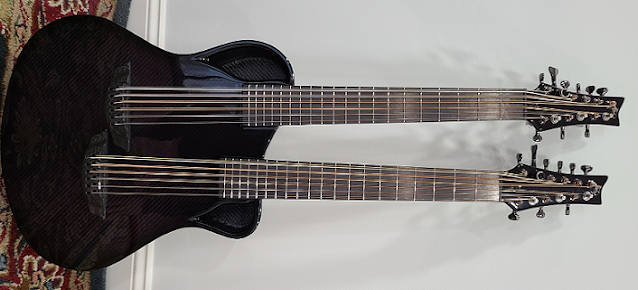24-string Double Subcontraguitar, Part 1
The 24-string Double Baritone arrived here in February 2023. It was originally designed and built to be a double baritone guitar, but I decided to entirely change the setup, tunings, and string gauges to make it into a double Subcontra guitar.
For my instruments, Contra tuning is defined as E tuning, one octave below concert E tuning, or the same tuning and register as the lower four strings on a bass. Subcontra tunings are anything below that. I currently have Subcontras in D, C#, and C.
Given Baritone registers and Contra registers, I am always drawn to the Contra registers as my preference and true voice. I do have two Baritone instruments; one 15-string and one 12. They have their place and are used in the studio for various projects. In fact, the 12-string Baritone was used on Strand in Strands on some pieces. Therefore, I feel like the baritone registers are well-covered. Which is why I decided to move the 24-string into the Subcontra register. Specifically, D Subcontra.
The Subcontra gauges wouldn't cause a problem with course spacing; when I spec'ed out the 24, I specified 2-inch nut widths on both necks. The string spacing/course spacing is really good and comfortable.
To make the conversion from Baritone to Subcontra, the following work was required.
- Adjusted both truss rods.
- Opened up the low D and low E string openings on the bridge.
- Slightly opened up some of the other bridge string holes for the heavier Subcontra gauges. The 24 has pinless bridges, so no bridge pin modifications were required.
- Shaved the right bridge saddle to match the left bridge saddle; took off around .030" from the base of the saddle. The right saddle was set up for G Baritone tuning/gauges, so it had to come down for the Subcontra tuning/gauges.
- Checked the nut slots. Re-filed a few to accommodate the Subcontra string gauges.
- Swapped out six Gotoh tuners for six Keith tuners.
- Swapped out the low D tuner on both sides for two Gotoh bass tuners. These were required for .100 gauge bass strings.
- Relocated the output jack. Most of my instruments have custom K&K stereo pickup systems, so a stereo output jack is required. When the 24 was built, the output jack was in the wrong location, so I had to fill the old hole, make a new hole in the proper location, and move/reinstall the output jack.
- New Subcontra string sets on both sides.
- After tuning it up with the new Subcontra gauges and the modified bridge saddles, I re-adjusted the truss rods a tiny bit.
- Put a tiny amount of Guitar Grease (graphite paste used for nut slot lubrication) on the threads of the adjuster nut on the cello fitting. It seemed uneven; now it's smoother.
After everything was complete, I plugged it in and did a pickup test in the studio. It sounded fantastic, and it was exciting to hear it in Subcontra D.
The bass strings are nickel-wound. For all the wound strings except the bass strings I'm using phosphor bronze. I might want to go to 80/20 bronze on a few courses.
Right now the gauges are really close to being right. If anything, I'll go slightly heavier in places. It took three or four years for me to really dial-in the perfect gauges on the 36-string Double Contraguitar, so this process is no different for finding the perfect gauges.
The 24 is built using the same body as the 28-string Double Contraguitar. One thing I've noticed in comparing these two instruments: the 24 has more of a cello-like voice in the upper registers. I like that.
Since this work was completed in February, I've been using the 24 on various album projects. It's gone from being what I thought would be a secondary or tertiary instrument to being one of my primary instruments. I look forward to further learning it and its voice. It will certainly be on album projects going forward.
-kk




Comments
Post a Comment